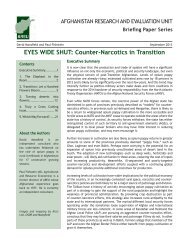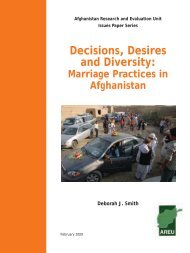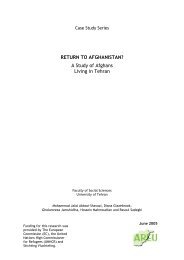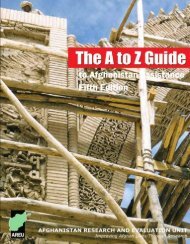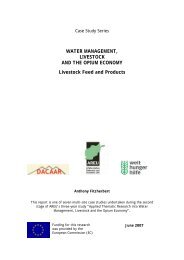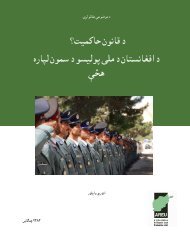Local Governance in Afghanistan: A View from the Ground
Local Governance in Afghanistan: A View from the Ground
Local Governance in Afghanistan: A View from the Ground
- No tags were found...
You also want an ePaper? Increase the reach of your titles
YUMPU automatically turns print PDFs into web optimized ePapers that Google loves.
<strong>Afghanistan</strong> Research and Evaluation Unit<br />
2011<br />
6.6 Conclud<strong>in</strong>g remarks<br />
Elections: The system of SNTV plays a major role <strong>in</strong> underm<strong>in</strong><strong>in</strong>g <strong>the</strong> development of party politics<br />
and, by requir<strong>in</strong>g relatively few votes to create w<strong>in</strong>ners, encouraged vote buy<strong>in</strong>g and brib<strong>in</strong>g of<br />
election officials. The electoral system and <strong>the</strong> representative bodies that derive <strong>from</strong> it have not<br />
yet <strong>in</strong>spired <strong>the</strong> confidence and trust of <strong>the</strong> people. Speed and transparency are essential to <strong>the</strong><br />
proper function<strong>in</strong>g of all electoral processes. There is an absence of both <strong>in</strong> <strong>the</strong> present system,<br />
where votes go to a central body and results emerge after several months. The system has not<br />
<strong>in</strong>spired a sceptical public. Voters <strong>in</strong> 2010’s Wolesi Jirga election saw <strong>the</strong> process as be<strong>in</strong>g used<br />
to legitimise <strong>the</strong> control of <strong>the</strong> powerful. The way it was conducted compounded a deep distrust<br />
of democratic process and state <strong>in</strong>stitutions. 109 Rightly or wrongly, and despite <strong>the</strong> efforts of <strong>the</strong><br />
Independent Election Commission, people <strong>in</strong>creas<strong>in</strong>gly assume <strong>the</strong> worst and perceive elections as<br />
a set of negotiated deals.<br />
Prov<strong>in</strong>cial councils: The <strong>in</strong>stitution of <strong>the</strong> prov<strong>in</strong>cial council represents a significant first step <strong>in</strong><br />
<strong>the</strong> establishment of a representative local government. However, <strong>the</strong> mantra used by prov<strong>in</strong>cial<br />
councils and o<strong>the</strong>rs with<strong>in</strong> government is that <strong>the</strong>y should form “a l<strong>in</strong>k between <strong>the</strong> government<br />
and <strong>the</strong> people.” Language such as this overlooks <strong>the</strong> key functions of representative bodies <strong>in</strong> <strong>the</strong><br />
democratic process, which is to hold <strong>the</strong> executive to account and to represent constituents. The<br />
legal framework for local government representative <strong>in</strong>stitutions has not provided a mean<strong>in</strong>gful<br />
separation of powers and as a consequence <strong>the</strong>re is nei<strong>the</strong>r transparency nor accountability.<br />
The resources available to prov<strong>in</strong>cial councils are slowly improv<strong>in</strong>g, as is <strong>the</strong>ir capacity to manage <strong>the</strong><br />
adm<strong>in</strong>istrative tasks associated with <strong>the</strong>ir mandate. However, any elected body that is represent<strong>in</strong>g<br />
somewhere <strong>in</strong> <strong>the</strong> region of half a million people 110 requires <strong>the</strong> resources of a secretariat and <strong>the</strong><br />
means to travel and do its work. It also requires regularly delivered tra<strong>in</strong><strong>in</strong>g that is consistent across<br />
<strong>the</strong> country.<br />
Districts: The achievements of <strong>the</strong> Helmand DCC model illustrate how a constituency-based approach<br />
to select<strong>in</strong>g district councillors can result <strong>in</strong> <strong>the</strong> formation of a body that engages <strong>in</strong> a vigorous<br />
debate on plann<strong>in</strong>g, prioritisation and resource allocation. What jo<strong>in</strong>ed <strong>the</strong>se DCCs toge<strong>the</strong>r was<br />
a common <strong>in</strong>terest <strong>in</strong> <strong>the</strong> development of <strong>the</strong>ir district <strong>in</strong>termixed with DCC members’ <strong>in</strong>dividual<br />
desires to get <strong>the</strong> best possible deal for <strong>the</strong>ir constituents and <strong>the</strong>mselves. The approach also<br />
generated a new relationship with <strong>the</strong> woluswal, who actually reported to <strong>the</strong> DCC and was subject<br />
to its question<strong>in</strong>g; this represents an important means of accountability. Despite problems such as<br />
<strong>the</strong> relatively high levels of <strong>in</strong>put required, <strong>in</strong> broad policy terms <strong>the</strong> approach provides a realistic<br />
mechanism for deliver<strong>in</strong>g resources and enhanc<strong>in</strong>g district level organisational capacity. Secondly,<br />
and most significantly, <strong>the</strong> Helmand model demonstrates <strong>the</strong> value of representation, transparency<br />
and accountability, <strong>the</strong> key elements of susta<strong>in</strong>able democratic governance.<br />
However, <strong>the</strong> study notes <strong>the</strong> tension between <strong>the</strong> ASOP/IDLG DCCs and <strong>the</strong> MRRD DDAs. It is<br />
unclear what <strong>the</strong> MRRD’s descriptions of DDAs’ “catalytic development facilitation role” and “multistakeholder<br />
coord<strong>in</strong>ation and oversight mechanism” precisely means when set aga<strong>in</strong>st <strong>the</strong> role and<br />
functions of <strong>the</strong> DCC. 111 In this crucial tier of local government <strong>the</strong> issue of duplication and areas of<br />
responsibility between <strong>the</strong> two bodies rema<strong>in</strong>s unresolved and is not assisted by a lack of clarity <strong>in</strong><br />
donor policy toward local government.<br />
Villages and Manteqas: The changes of recent decades have <strong>in</strong>creased <strong>the</strong> importance of <strong>the</strong> village<br />
as a place where people locate <strong>the</strong>ir identity and sense of belong<strong>in</strong>g. Many groups had traditionally<br />
109 Noah Coburn and Anna Larson, “Underm<strong>in</strong><strong>in</strong>g Representative <strong>Governance</strong>” (Kabul: <strong>Afghanistan</strong> Research and Evaluation<br />
Unit, 2011), 15.<br />
110 Accord<strong>in</strong>g to CSO Population data 2010-11, exclud<strong>in</strong>g prov<strong>in</strong>ces with large urban centres, Kunduz has <strong>the</strong> largest<br />
population with 917,900 and Nuristan <strong>the</strong> smallest with 136,300.<br />
111 “NABDP 1st Quarter Project Progress Report–2010,” 5.<br />
<strong>Local</strong> <strong>Governance</strong> <strong>in</strong> <strong>Afghanistan</strong>: A <strong>View</strong> <strong>from</strong> <strong>the</strong> <strong>Ground</strong><br />
51



